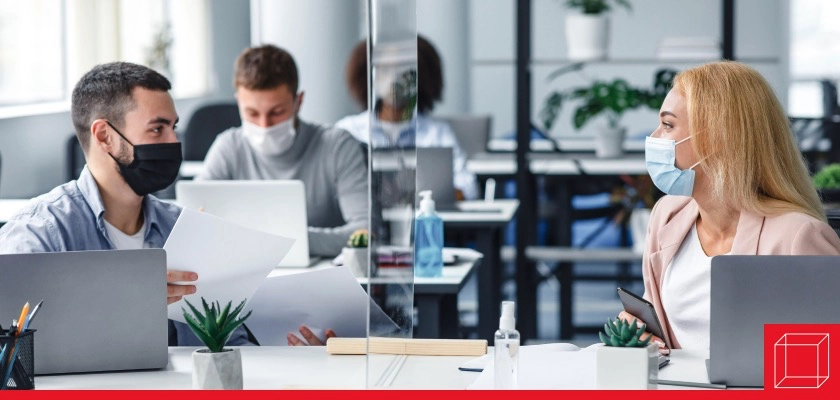The Sociology of “Back to Normal”: Post-Pandemic Life - Sophie Nathenson, Ph.D. | Nov 2022
Weeks into the Covid-19 Pandemic, we began hearing the phrase “the new normal” from politicians, mainstream and social media outlets, and many of our friends and family.
Oregon Tech

Weeks into the Covid-19 Pandemic, we began hearing the phrase “the new normal” from politicians, mainstream and social media outlets, and many of our friends and family. This phrase is not new and has a sociological function of quelling collective anxiety about major changes from a crisis. While societies around the world were coping with the global health crisis in varied ways, America’s new normal also varied dramatically and inequitably among different groups. To better understand the underlying structure of society, sociologists study human behavior by comparing groups. This reveals how various social factors impact behavior in society. For example, looking at the social factor of “occupation,” the new normal looked different across work settings. A nurse, a teacher, and a grocery store clerk all experienced changes during the pandemic, but in different ways. Many individuals experienced a new norm of more virtual life, yet nearly half of the globe still lacks access to the internet (ITU 2019). Wearing masks, social distancing, and dramatic shifts in working conditions and family dynamics all impacted behavior, mental health, and physical well-being. Concurrently, mortality rates from Covid varied drastically across economic and racial groups. In the U.S. city of Chicago, 70% of Covid deaths were of African Americans, even though they make up 30% of the population (Maqbool 2020).
So, who decides when we are “back to normal”—and what is normal? Are there permanent changes to social norms post-pandemic? When are we “post-pandemic,” and what does that mean? What are the impacts of the pandemic on our social lives—during, after, and moving forward?
Things are still murky as to where we are as a society in terms of normalcy. One poll measured the extent to which people are “engaging in the same activities that they did pre-pandemic” (Sparks et al. 2022). Race, vaccine status, underlying health conditions, and political affiliation were social factors that were included. Results showed that about six out of ten adults have not returned to “normal,” as measured by their engagement in pre-pandemic activity. More than one in ten never changed their routine. This indicator differs by political affiliation and vaccine status: 35% of Republicans versus 21% of Democrats have returned to their normal, and 28% of unvaccinated adults versus 10% of vaccinated adults say they never altered their routine. These results also differed by chronic conditions, racial identity, and income, with those with no chronic conditions, those with higher income, and whites more likely to be feeling and acting like they are back to normal (Sparks et al. 2022).
Aside from individual activities, are we, as a society, back to pre-pandemic life? Life in the pandemic was like putting our entire society under a microscope, and the crisis brought to the surface many underlying issues that sociologists have been investigating for decades, such as social and political inequality; poor physical health in the form of chronic, persisting conditions driven in part by economics and culture; and mental health conditions, including serious addictions. We now know that the social isolation of the pandemic increased suicidal ideation, substance abuse, depression, and anxiety (Czeisler et al. 2020). This perhaps sheds light on our collective mental, emotional, and social wellbeing. Is there evidence that our social environments, such as work and school, will adjust to promote better mental health? If there were a time to try, it would be now. Many workplaces are changing policies to offer hybrid and remote work where possible, creating a better personal–professional life balance.
It is rare to have a social experiment on such a large scale, where many people around the globe are tuning in to what is happening social and economically like never before, after taking a collective time-out from typical work and social environments. At the same time, sometimes within the same society, people are experiencing more extreme working conditions than ever before, with no time out. Societal pressures compound the stress of the physical and emotional work for those on the front lines of medicine, transportation, food systems, and others, putting unprecedented strain on mental health and relationships (Long et al. 2022). As for the question of when we are back to normal post-pandemic, social institutions of medicine and public health organizations have weighed in with a number. In this context, 165 deaths per day is “acceptable” (Flaskerud 2022). Applying that equation, we now live in a state of normalcy. But in terms of social norms, the disruption of the pandemic has the power to shift how we relate, respond to emergencies, and even consider the well-being of our society.
Discussion Questions
How have your activities changed, from before the pandemic, to now? What do you think was the primary reason you made these changes?
What social changes that happened due to the pandemic do you feel should continue post-pandemic? Why?
References
Czeisler, M. É., Lane, R. I., Petrosky, E., Wiley, J. F., Christensen, A., Njai, R., … & Rajaratnam, S. M. (2020). Mental health, substance use, and suicidal ideation during the COVID-19 pandemic—United States, June 24–30, 2020. Morbidity and Mortality Weekly Report, 69(32), 1049.
Flaskerud, J. H. (2022). Declaring an End to the Pandemic: What Are the Issues?. Issues in Mental Health Nursing, 43(6), 578-581.
International Telecommunication Union. (2019). Measuring digital development: Facts and figures 2019.
Long, E., Patterson, S., Maxwell, K., Blake, C., Pérez, R. B., Lewis, R., ... & Mitchell, K. R. (2022). COVID-19 pandemic and its impact on social relationships and health. J Epidemiol Community Health, 76(2), 128-132.
Maqbool, A. (2020). Coronavirus: why has the virus hit African Americans so hard?. BBC News.
Sparks, G., Hamel, Liz, Kirzinger, A., Montero, A., and Brodie, M. 2022. KFF COVID-19 Vaccine Monitor: Views On The Pandemic At Two Years. Accessed at https://www.kff.org/coronavirus-covid-19/poll-finding/kff-covid-19-vaccine-monitor-pandemic-two-years/ on September 29, 2022.




